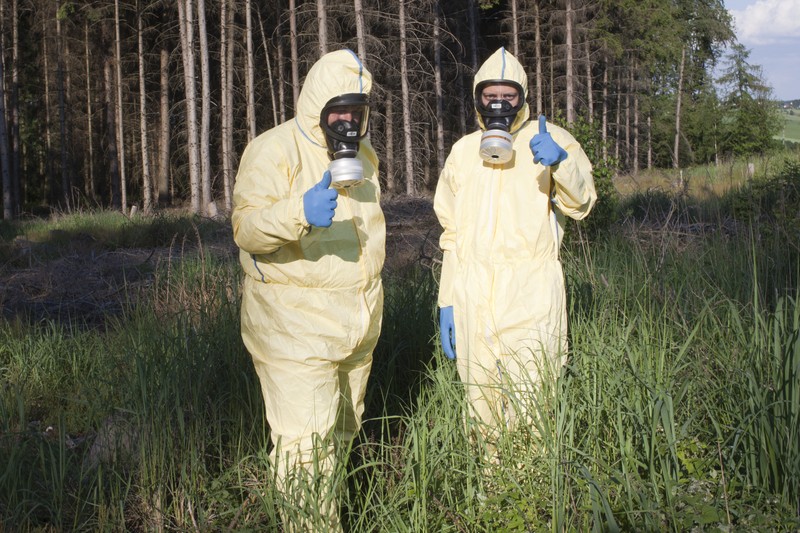God willing, this may never be an issue during our lifetime but if it is we – all of us – will want to be prepared. Too many things are happening these days, politically and ideologically. Who knows what world power will blink first! Save yourself a lot of grief and read the advice given below regarding radiation sickness and how to deal with it!
PROTECTION AGAINST EXPOSURE TO RADIATION
In the early going, your goal is to prevent exposures of over 100 RADS. A radiation dosimeter will be useful to gauge radiation levels and is widely available for purchase. This item will give you an idea of your likelihood of developing radiation sickness.
There are three basic ways of decreasing the total dose of radiation:
1) Limit the time unprotected. Radiation absorbed is dependent on the length of exposure. Leave areas where high levels are detected and you are without adequate shelter. The activity of radioactive particles decreases over time. After 24 hours, levels usually drop to 1/10 of their previous value or less.
2) Increase the distance from the radiation. Radiation disperses over distance and effects decrease the farther away you are.
3) Provide a barrier. A shelter will decrease the level of exposure, so it is important to know how to construct one that will serve as a shield between your people and the radiation source. A dense material will give better protection that a light material.DIFFERENT MATERIALS AS BARRIERS
Radiation burns post-Hiroshima bombing
The more material that you can use to separate yourself from fallout, the more likely you won’t suffer ill effects. Barrier effectiveness is measured as “halving thickness”. This is the thickness of a particular shield material that will reduce gamma radiation (the most dangerous kind) by one half. When you multiply the halving thickness, you multiply your protection.
For example, the halving thickness of concrete is 2.4 inches or 6 centimeters. A barrier of 2.4 inches of concrete will drop radiation exposure by one half. Doubling the thickness of the barrier again (4.8 inches of concrete) drops it to one fourth (1/2 x 1/2) and tripling it (7.2 inches) will drop it to one eighth (1/2 x 1/2 x 1/2), etc. Ten halving thicknesses (24 inches of concrete) will drop the total radiation exposure to 1/1024th that of being out in the open.
Here are the halving thicknesses of some common materials:
Lead: 0.4 inches or 1.02 centimeter
Steel: 1 inch or 2.54 centimeters
Concrete: 2.4 inches or 6.09 centimeters
Soil (packed): 3.6 inches or 9.14 centimeters
Water: 7.2 inches or 18.28 centimeters
Wood: 11 inches or 27.94 centimeters
By looking at the list above, you can see that the same protection is given with 1/6 the thickness of lead plating as that of concrete.TREATING RADIATION SICKNESS
Eliminating external contamination with fallout “dust” is important before absorption occurs. This can be accomplished d with simple soap and water. Scrub the area gently with a clean wet sponge. Safely dispose of the sponge and dry the area thoroughly.
Internal contamination is a more difficult issue. Emergency treatment involves dealing with the symptoms. Once the diagnosis is made, methods that may help include antibiotics to treat infections, fluids for dehydration, diuretics to flush out contaminants, and drugs to treat nausea. In severely ill patients, stem cell transplants and multiple transfusions are indicated but will not be options in an austere setting. This hard reality underscores the importance of having an adequate shelter to prevent excessive exposure.
Protection is available against some of the long term effects of radiation. Potassium Iodide (known by the chemical symbol KI), taken orally, can prevent radioactive Iodine from damaging the specific organ that it targets, the thyroid gland. The usual adult dose is 130 mg daily for 7-10 days or for as long as exposure is significant. For children, the dosage is 65 mg daily. KI is available in a FDA-approved commercial product called Thyrosafe.
Thyrosafe (Potassium Iodide)
Taking KI 30 minutes to 24 hours prior to a radiation exposure will prevent the eventual epidemic of thyroid cancer that will result if no treatment is given. Radiation from the 1986 Chernobyl disaster has accounted for more than 4,000 cases of thyroid cancer so far, mostly in children and adolescents. Therefore, if you only have a limited quantity of KI, treat the youngsters first.
Although there is a small amount of KI in ordinary iodized salt, not enough is present to confer any protection by ingesting it. It would take 250 teaspoons of household iodized salt to equal one Potassium Iodide tablet.
Pets may also be at risk for long-term effects from radioactive iodine. It is recommended to consider 1/2 tablet daily for large dogs, and 1/4 tablet for small dogs and cats.
To learn more, including an alternative remedy for radiation exposure, go to Survival Medicine!
No, it is not something we want to think about but, as conscientious survivors and preppers, we have to. This will not be an easy world to live in after a collapse but, with the knowledge we gain through survival experts and outdoorsmen, we will survive and have a future! We will bring this world back and allow our ancestors to live in it happily!
